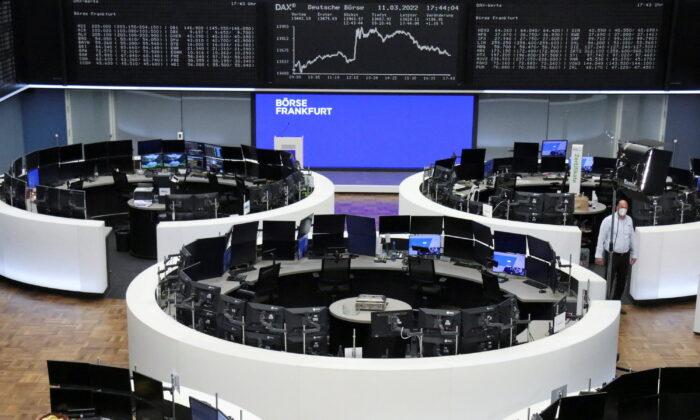LONDON—European stock indexes opened slightly higher on Tuesday, while U.S. and European government bond yields rose to new multiyear highs as investors adjusted their expectations for rate hikes following hawkish comments from the U.S. Federal Reserve.
Fed Chair Jerome Powell said that the central bank could move “more aggressively” to raise rates to fight inflation, possibly by more than 25 basis points at once.
Markets scrambled to recalibrate the higher possibility of a 50 bps hike. On Tuesday morning, money markets were pricing in an 80 percent chance of a 50 bps hike in May.
At 0853 GMT, the U.S. 10-year Treasury yield was at 2.3497 percent, its highest since 2019.
RBC Capital Markets’ chief U.S. economist, Tom Porcelli, wrote in a note to clients that during the speech “it was easy to wonder if a 75bps hike or even going intra-meeting is possible.”
“Both outcomes seem incredibly extreme but when we hear Powell talk about inflation he comes off as incredibly anxious to us.”
Eurozone government bond yields also rose, with Germany’s benchmark 10-year yield hitting a new 2018 high of 0.51 percent.
Although Wall Street had closed lower after Powell’s comments, stock markets in Europe opened a touch higher, with the MSCI world equity index, which tracks shares in 50 countries, up 0.2 percent on the day.
The STOXX 600 was up 0.5 percent, having climbed high in recent sessions to reach a one-month high. London’s FTSE 100 was up 0.6 percent.
“With positioning light, sentiment weak, and geopolitical risks likely to ease over time, we believe risks are skewed to the upside,” wrote JPMorgan strategists in a note to clients.
JPMorgan said that 80 percent of its clients plan to increase equity exposure, which is a record high.
The conflict in Ukraine continued to weigh on sentiment.
Oil prices continued to rise overnight following news that some European Union members were considering imposing sanctions on Russian oil—although Germany said that the bloc was too dependent on Russian oil and gas to be able to cut itself off.
But prices dropped around 0800 GMT, with Brent crude futures down 0.9 percent on the day by 0916 GMT and West Texas Intermediate futures down 0.7 percent.
The U.S. dollar index was up 0.1 percent at 98.61, while the euro was a touch lower at $1.1009.
The Japanese yen plunged past the 120 level versus the dollar, hurt by the divergent rate-hike expectations for the United States and Japan.
“The perception that the JPY may become a funding currency rather than a safe-haven unit after the BoJ made it clear that they do not want to hike rates at present has further helped USD-JPY break above the key 120 threshold,” UniCredit said in a client note.
In cryptocurrencies, bitcoin was up 3.6 percent at around $42,515.






Friends Read Free